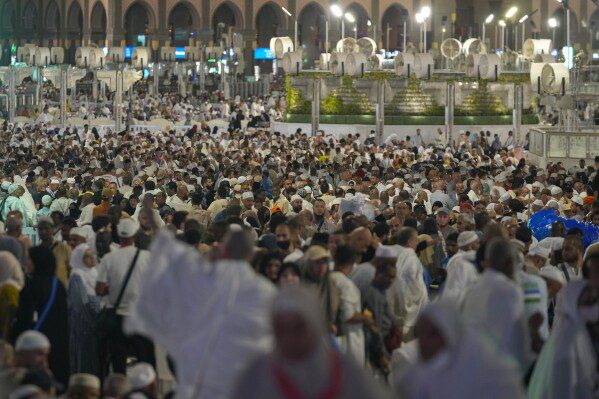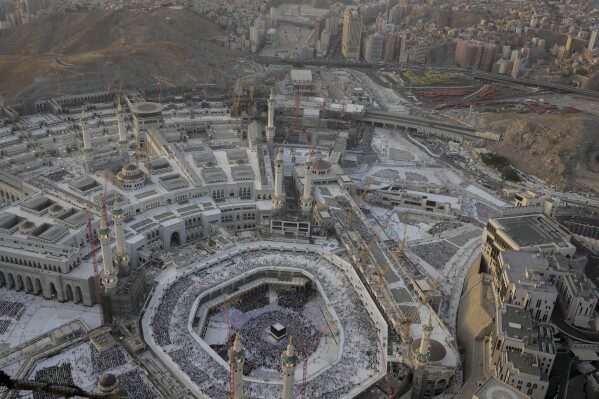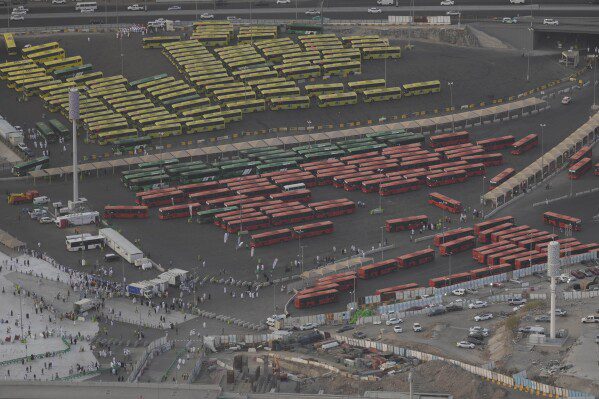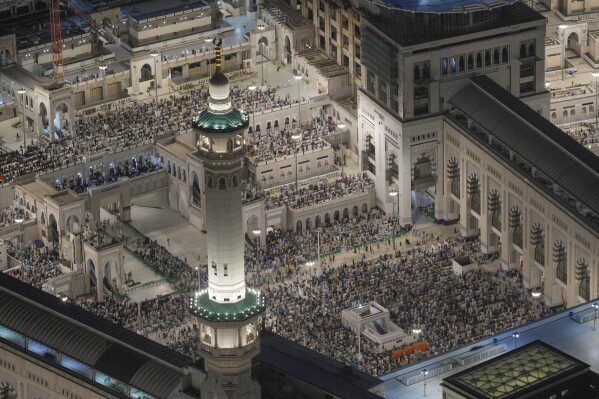MECCA, Saudi Arabia (AP) — Muslim pilgrims are flocking to the holy city of Mecca, Saudi Arabia, ahead of the start of the Hajj season later this week, with the annual Hajj returning to its massive size.
Saudi officials say more than 1.5 million foreign pilgrims had arrived in the country by Tuesday, the vast majority by air, from all over the world. More are expected to join them, and hundreds of thousands of Saudis and others living in Saudi Arabia will join them when the Hajj officially begins on Friday.

Muslim pilgrims pray at the Grand Mosque, during the annual Hajj in Mecca, Saudi Arabia, Tuesday, June 11, 2024. (AP Photo/Rafiq Maqbool)
Saudi officials said they expect the number of pilgrims this year to exceed 2023, with more than 1.8 million people performing the Hajj, which is close to pre-pandemic levels. In 2019, more than 2.4 million Muslims performed the Hajj. The Saudi authorities control the flow of pilgrims through quotas, allowing each country one pilgrim for every thousand Muslim citizens.
Among the pilgrims were 4,200 Palestinians from the occupied West Bank who arrived in Mecca earlier this month, according to the Palestinian Ministry of Endowments and Religious Affairs. Palestinians in the Gaza Strip were unable to travel to Saudi Arabia to perform Hajj this year, due to the ongoing eight-month war between Israel and Hamas.
Ibrahim Al-Hadary, an Algerian pilgrim, said: “We pray for Palestine to be liberated and for (the Palestinians) to liberate their land and to be like other nations, and to live in peace and not always in a state of war.” Standing in the courtyard of the Grand Mosque waiting for the evening prayer.
On Tuesday, pilgrims gathered at the Grand Mosque in Mecca, performing a ritual that walked seven times around the Kaaba, the cubic structure inside the mosque considered the holiest site in Islam. They wore the ihram, which consisted of two unstitched pieces of white cloth that resembled a shroud.
Many of them were seen sweating profusely from the hot sun, and others were carrying umbrellas against the sun as temperatures reached 42 degrees Celsius (107 Fahrenheit) and 45 degrees Celsius (113 Fahrenheit) during the day on Tuesday and Wednesday, respectively.
“I felt relieved when I reached the Grand Mosque and saw the Kaaba,” said Rabiaa Al-Rajhi, a Moroccan woman who came to Mecca for Hajj with her husband and their daughter. “I’m very happy.”
Muhammad Abdel Basit, an Iraqi pilgrim, said that he felt extremely happy to perform the Hajj rituals.
Lawyer Abdul Basit from Baghdad said: “We congratulate the large crowd and thank God for bringing us together from all regions globally and not just from the Arab world, from all global Muslim regions (who) came to the Grand Mosque.” .
At night, the vast marble square around the Kaaba was crowded with believers, walking side by side, often running into barricades set up by security forces to direct the massive flows of people in and around the Grand Mosque.
Pilgrims perform the circumambulation, known as “tawaf” in Arabic, upon their arrival in Mecca. The large crowds circumambulating the Kaaba will continue until the first day of Hajj.

Muslim pilgrims circumambulate the Kaaba, the cubic structure in the Grand Mosque, during the annual Hajj in Mecca, Saudi Arabia, Tuesday, June 11, 2024. (AP Photo/Rafiq Maqbool)
On Friday, pilgrims will move to Mount Arafat for a full-day stop, then to Muzdalifah, a rocky plain a few miles away. In Muzdalifah, pilgrims collect pebbles to use in stoning the pillars that symbolically represent Satan in Mina.
The Hajj is one of the largest religious gatherings in the world, and is one of the five pillars of Islam. All Muslims must do this at least once in their lives if they are physically and financially able to do so.
Pilgrims view Hajj as an opportunity to strengthen their faith, erase old sins and start new.

Buses of pilgrims line up during the annual Hajj in Mecca, Saudi Arabia, Tuesday, June 11, 2024. (AP Photo/Rafiq Maqbool)
___
Associated Press religion coverage receives support through the AP cooperation With The Conversation US, funded by the Lilly Endowment Inc., the AP is solely responsible for this content.


